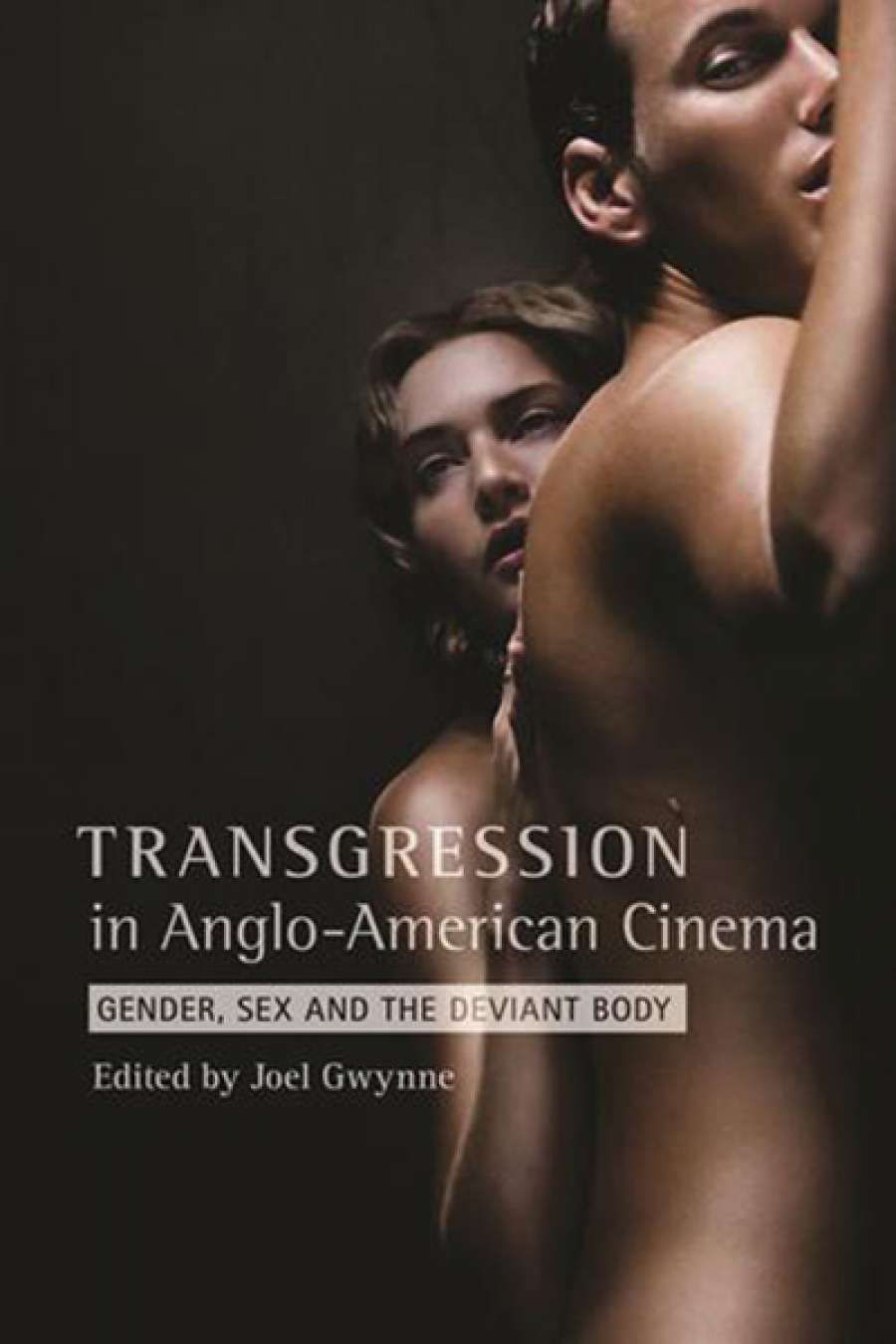
- Free Article: No
- Contents Category: Film
- Custom Article Title: Dion Kagan reviews 'Transgressions in Anglo-American Cinema: Gender, sex and the deviant body' edited by Joel Gwynne
- Custom Highlight Text:
As long as there have been moving images, people have fretted about cinema’s special dexterity at breaching sexual and social norms. We now have sophisticated tools to help us ...
- Book 1 Title: Transgressions in Anglo-American Cinema
- Book 1 Subtitle: Gender, sex and the deviant body
- Book 1 Biblio: Columbia University Press (Wallflower Press) $49.95 pb, 256 pp, 9780231176057
'Transgression' may have been a particular fixation of 1990s scholarship and identity politics, but as a lens for examining sex/gender regulation it still has much explanatory power, even in our permissive times. Transgressions in Anglo-American Cinema often does what this work does best, which is identify trends in popular culture that hint at larger structures of regulation in everyday life.
Some of the deviants of this collection are new-fangled personifications of old transgressors. Judi Dench’s unforgettable turn as the embittered Barbara in Notes on a Scandal (2006) is an unapologetic rehash of the psychotic spinster figure whose unfulfilled lesbian desires have made her a predatory monster. But, as Eva Krainitzki argues, the film’s horrified fascination with the ‘unwatchable’ ageing woman responds to a contemporary fixation with 'graceful' and sexless ageing among older women. The psychotic woman is an antidote to that, a source of symbolic erotic possibility: Krainitzki suggests we can appropriate Barbara’s scandal of disgraceful ageing for its queer and gender-transgressive appeal.
Two essays examining what Alistair Fox dubs ‘The New Anglo-American Cinema of Sexual Addiction’ are best read together. Fox offers a taxonomy: McQueen’s Shame (2011) and Lars von Trier’s Nymphomaniac (2013), among others, scrutinise characters stuck in ‘patterns of intensifying escalation’, spiralling toward humiliation, misery, and self-destruction. It is a largely despairing genre; if redemption is offered it is in ‘relational sex’ (that is, love) and the provenance of the film is more likely the United States. As for analysis, Fox frames the sex-addiction cycle as part of the sex panic about ‘pornification’, and as another type of backlash against sexual revolution culture gone too far. Fox is wrong to suggest that these films are ‘devoid of titillation’, and he overlooks some revealing genealogies in Eurosleaze, the French cinema of brutal intimacy, and decades of queer cultural production across media forms. It might be telling, for example, that so many of these sex addicts are straight men, echoing recent public scandals about sex-addled celebrities, and the hand-wringing about men’s exposure to pornography. The insatiable straight man is a problem for masculinity because his capacity for endless encounters and his loss of self-control moves him beyond the territory of heroic virility into the at-risk realms reserved for prostitutes and promiscuous gay men, and thus sexual epidemics and, again, the spectre of emasculation. Fox would have done well to consult queer theory and early AIDS cultural criticism: a contextualising essay on contemporary sex addiction cinema that ignores queer experience is galling precisely because it images homo and hetero as part of separate cultural orders unaffected by the very same conditions of existence.
Fox’s taxonomy works nicely to present the raw material for Mark Featherstone’s ‘carnotopia’ analysis in the next chapter, where an insatiable sex drive is the miserable logic of late capitalism – the reduction of the human sexual relation to a ‘soulless, base, commodity exchange’. It would be another rehashing of an old (Freudian, Baudrillardian) idea, if it didn’t address the intimate life of neo-liberal sex in fresh, resonant, persuasive ways. Featherstone’s ‘carnotopia’ is an interesting and potentially breakthrough concept because it acknowledges that sex-as-capital is both liberating and utterly ruinous in its effects – utopian and dystopian all at once. It turns out that the real terror in Anglo-American cultures is our ambivalence about sexual freedom.
 Lars von Trier, director of the 2013 film Nymphomaniac (photograph by Siebbi, Wikimedia Commons)
Lars von Trier, director of the 2013 film Nymphomaniac (photograph by Siebbi, Wikimedia Commons)
The second half of the collection considers the relentless anxiety about the sexuality of the young and the under-age. Amy Chambers looks at films like Little Children, Hard Candy, and Mysterious Skin that upend some cherished sexual definitions: the monstrous evil of the sex offender/paedophile and the sexual innocence of the child. Joel Gwynne, the book’s editor, introduces a new figure – the Lindsay Lohan/Britney Spears-style ‘crash and burn girl’ – that might help to refine an understanding of the endless oscillation between ‘can do’ and ‘at risk’ in the hysteria around the tween/teenage girl and her precocious shopping and sex practices. Gwynne is good and so is Chambers; Demirkan-Martin’s reading of Clint Eastwood’s Mystic River as homophobic parable of spoiled masculinity is on the money but makes the same argument Joe Wlodarz made in ‘Rape Fantasies’ (2001) fifteen years ago, with no mention of Leo Bersani’s germinal theory on masculine spoilage, ‘Is the Rectum a Grave’ (1987). If it had only paid more attention to the director’s recent films, the penultimate essay on queer adolescents in 1990s, Gregg Araki might have added something new and seemed less out of place.
As with most scholarly essay collections, this is a mixed bag, but as a snapshot its editor’s interest in ‘articulations of queer heterosexuality’ is sharply in focus. As a gender-fluid, non-reproductive, pleasure-oriented force in contemporary cinema, heterosexuality has never been more queer.


Comments powered by CComment